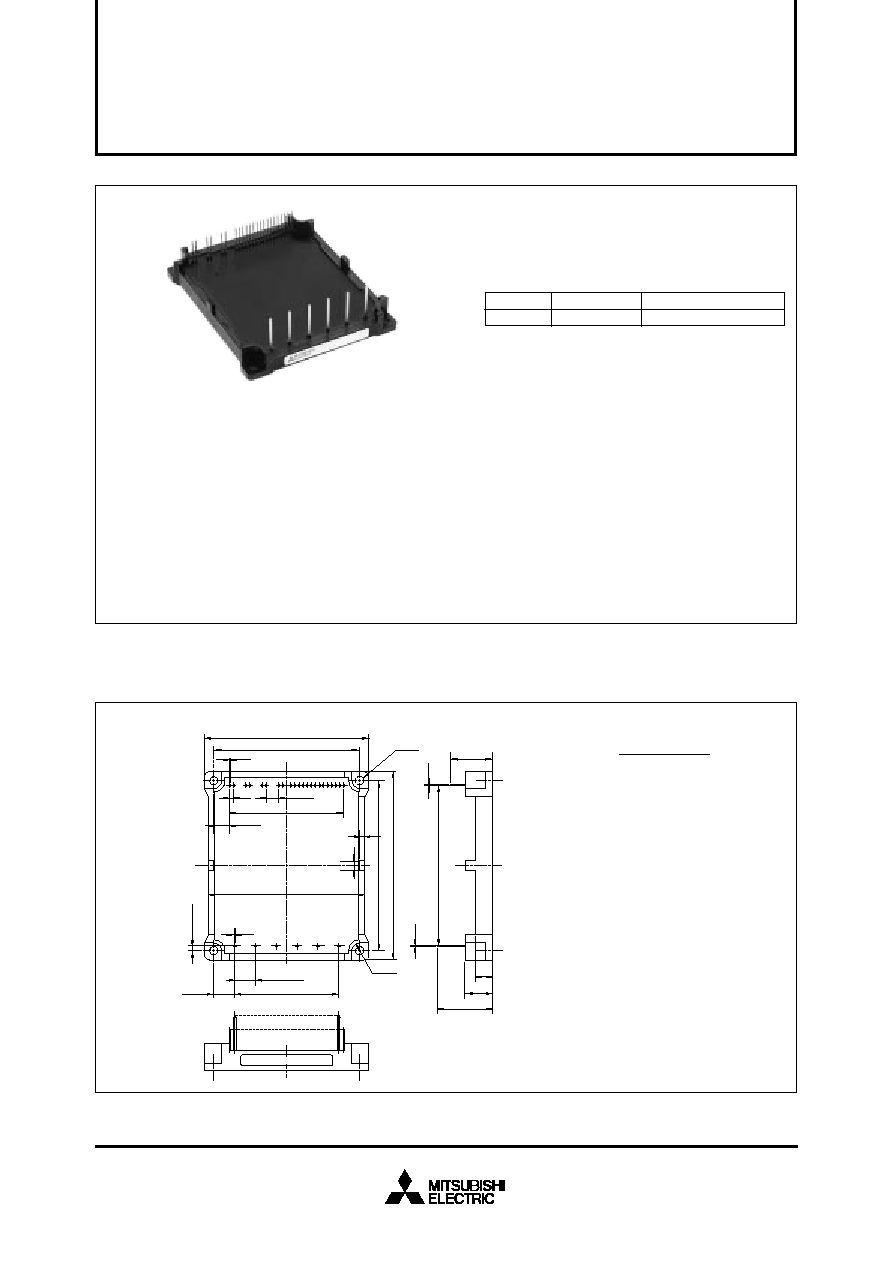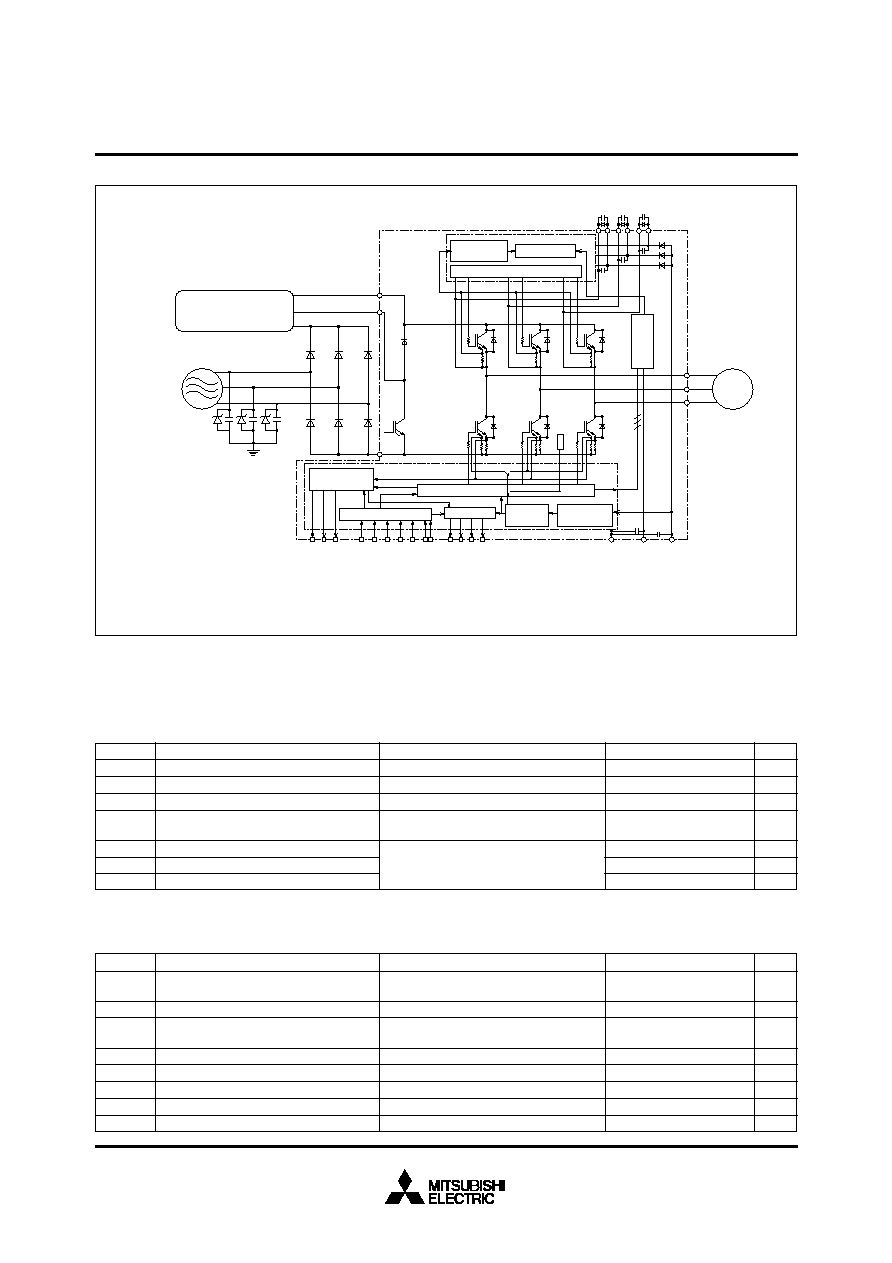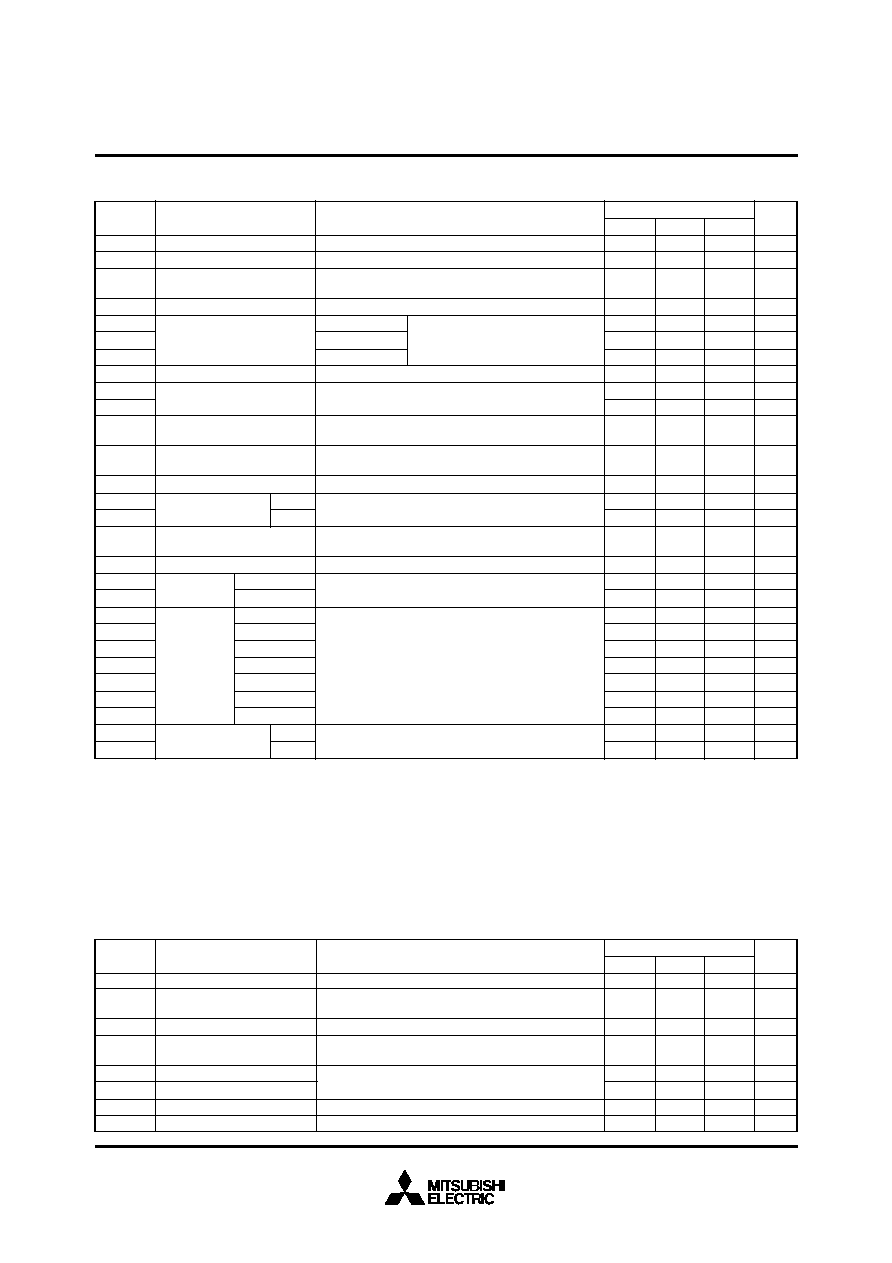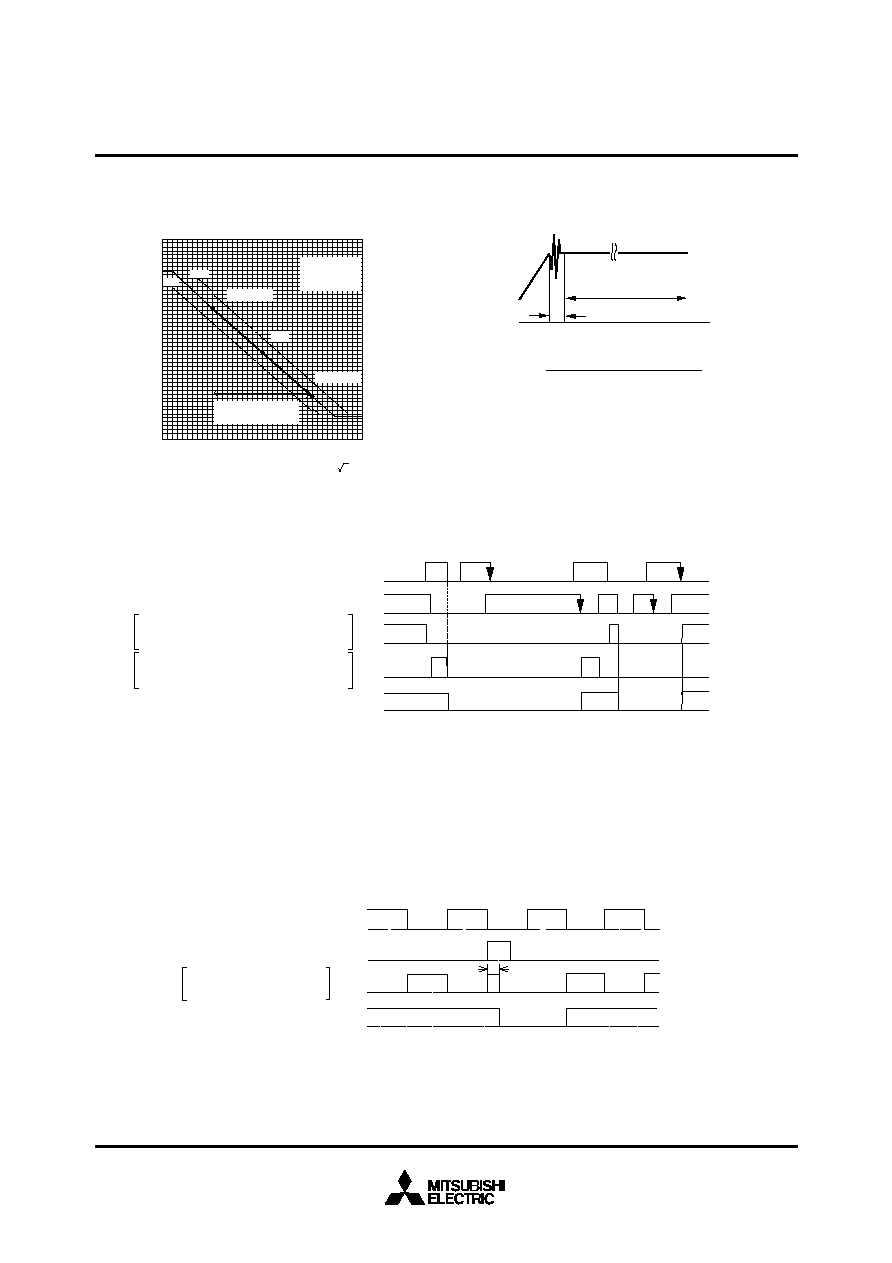 | –≠–ª–µ–∫—Ç—Ä–æ–Ω–Ω—ã–π –∫–æ–º–ø–æ–Ω–µ–Ω—Ç: PS12013-A | –°–∫–∞—á–∞—Ç—å:  PDF PDF  ZIP ZIP |

MITSUBISHI SEMICONDUCTOR <Application Specific Intelligent Power Module>
PS12013-A
FLAT-BASE TYPE
INSULATED TYPE
Jan. 2000
4-
4
13
8.5
(7.75)
2
±
0.3
92.5
±
1
2.45
±
0.3
83.5
±
0.5
6
±
0.3
56
±
0.8
71.5
±
0.5
80.5
±
1
0.6
0.5
78.75
1.2
31
32
34
35
36
4-R4
LABEL
33
0.5
2.5
23
1
76.5
±
1
20.4
±
1
50.8
±
0.8
27
±
1
10.16
±
0.3
5
(10.35)
1 CBU+
2 CBU≠
3 CBV+
4 CBV≠
5 CBW+
6 CBW≠
7 GND
8 VDL
9 VDH
10 CL
11 FO1
12 FO2
13 FO3
14 CU
15 CV
16 CW
17 UP
18 VP
19 WP
20 UN
21 VN
22 WN
23 Br
31 P
32 B
33 N
34 U
35 V
36 W
Terminals Assignment:
PS12013-A
PACKAGE OUTLINES
MITSUBISHI SEMICONDUCTOR <Application Specific Intelligent Power Module>
PS12013-A
FLAT-BASE TYPE
INSULATED TYPE
(Fig. 1)
INTEGRATED FUNCTIONS AND FEATURES
∑ 3-Phase IGBT inverter bridge configured by the latest 3rd.
generation IGBT and diode technologies.
∑ Circuit for dynamic braking of motor regenerative energy.
∑ Inverter output current capability Io (Note 1) :
INTEGRATED DRIVE, PROTECTION AND SYSTEM CONTROL FUNCTIONS:
∑ For P-Side IGBTs : Drive circuit, High-speed photo-couplers, Short circuit protection (SC),
Bootstrap circuit supply scheme (Single drive power supply ) and Under-voltage protection (UV).
∑ For N-Side IGBTs : Drive circuit, Short-circuit protection (SC), Control supply Under voltage and Over voltage protection (OV/UV),
System Over temperature protection (OT), Fault output signaling circuit (Fo), and Current-Limit warning signal out-
put (CL).
∑ For Brake circuit IGBT : Drive circuit.
∑ Warning and Fault signaling :
F
O1
: Short circuit protection for lower-leg IGBTs and Input interlocking against spurious arm shoot-through.
F
O2
: N-side control supply abnormality locking (OV/UV)
F
O3
: System over-temperature protection (OT).
CL : Warning for inverter current overload condition
∑ For system feedback control : Analogue signal feedback reproducing actual inverter output phase current (3
).
∑ Input Interface : 5V CMOS/TTL compatible, Schmitt trigger input, and Arm-Shoot-Through interlock protection.
Type Name
PS12013-A
100% load
1.8A (rms)
150% over load
2.7A (rms), 1min
(Note 1) : The inverter output current is assumed to be sinu-
soidal and the peak current value of each of the
above loading cases is defined as : Iop = Io
!
2
APPLICATION
Acoustic noise-less 0.4kW/AC400V Class 3 Phase inverter and other motor control applica-
tions.

MITSUBISHI SEMICONDUCTOR <Application Specific Intelligent Power Module>
PS12013-A
FLAT-BASE TYPE
INSULATED TYPE
Jan. 2000
CBU≠
CBU+
CBV≠
CBV+
CBW≠
CBW+
GND
VDL VDH
Fo Logic
Application Specific Intelligent
Power Module
CU CV CW
CL,FO
1
,FO
2
,FO
3
U
P
V
P
W
P
V
N
W
N
B
r
U
N
B
P
Protection
Circuit
Photo
Coupler
Input Circuit
Drive Circuit
Drive Circuit
Input signal conditioning
Current sensing
circuit
Protection
circuit
Control supply
fault sense
R
S
T
Z : Surge absorber.
C : AC filter (Ceramic condenser 2.2~6.5nF)
[Note : Additionally an appropriate Line-to line
surge absorber circuit may become necessary
depending on the application environment].
C
Z
N
M
W
AC 400V class
line output
V
U
Brake resistor connection,
AC 400V class line input
Inrush prevention circuit,
etc.
T
S
Analogue signal output corresponding to
each phase current (5V line) Note 1)
PWM input
(5V line) Note 2)
Note 1) To prevent chances of signal oscillation, a series resistor (1k
) coupling at each output is recommended.
Note 2) By virtue of integrating a photo-coupler inside the module, direct coupling to CPU, without any extemal opto or transformer isolation is possible.
Note 3) All outputs are open collector type. Each signal line should be pulled up to plus side of the 5V power supply with approximately 5.1k
resistance.
Note 4) The wiring between power DC link capacitor and P/N terminals should be as short as possible to protect the ASIPM against catastrophic high surge voltage.
For extra precaution, a small film snubber capacitor (0.1~0.22
µ
F, high voltage type) is recommended to be mounted close to these P and N DC power input pins.
Fault output
(5V line) Note 3)
INTERNAL FUNCTIONS BLOCK DIAGRAM
(Fig. 2)
±
Ic(
±
Icp)
Ic(Icp)
I
F
(I
FP
)
V
V
V
900
1000
1200
Applied between P-N
Applied between P-N, Surge-value
Applied between P-U, V, W, Br or U, V, W, Br-N
Supply voltage
Supply voltage (surge)
Each output IGBT collector-emitter static voltage
Condition
Symbol
Item
Ratings
Unit
V
CC
V
CC(surge)
V
P
or V
N
MAXIMUM RATINGS
(Tj = 25
∞
C)
INVERTER PART (Including Brake Part)
V
P(S)
or
V
N(S)
Each output IGBT collector-emitter surge voltage
Each output IGBT collector current
Brake IGBT collector current
Brake diode anode current
Applied between P-U, V, W, Br or U, V, W, Br-N
T
C
= 25
∞
C
Note : "( )" means I
C
peak value
1200
±
5 (
±
10)
5 (10)
5 (10)
V
A
A
A
V
CIN
V
FO
I
FO
V
CL
I
CL
I
CO
V
7
Applied between V
DL
-GND
Supply voltage
V
DL
Symbol
Item
Ratings
Unit
CONTROL PART
Condition
Input signal voltage
Fault output supply voltage
Fault output current
Current-limit warning output voltage
CL output current
Analogue-current-signal output current
≠0.5 ~ V
DL
+0.5
V
V
mA
V
mA
mA
Applied between U
P
∑ V
P
∑ W
P
∑ U
N
∑ V
N
∑
W
N
∑ B
r
-GND
Applied between F
O1
∑ F
O2
∑ F
O3
-GND
Sink current of F
O1
∑ F
O2
∑ F
O3
Applied between CL-GND
Sink current of CL
Sink current of CU ∑ CV ∑ CW
≠0.5 ~ 7
15
≠0.5 ~ 7
15
±
1
V
DH
, V
DB
Supply voltage
V
20
Applied between V
DH
-GND, C
BU+
-C
BU≠
,
C
BV+
-C
BV≠
, C
BW+
-C
BW≠

MITSUBISHI SEMICONDUCTOR <Application Specific Intelligent Power Module>
PS12013-A
FLAT-BASE TYPE
INSULATED TYPE
Jan. 2000
T
C
Condition
Symbol
Item
Ratings
Unit
(Note 2)
--
(Fig. 3)
60 Hz sinusoidal AC for 1 minute, between all terminals
and base plate.
Mounting screw: M3.5
T
j
T
stg
T
C
V
ISO
--
Junction temperature
Storage temperature
Module case operating temperature
Isolation voltage
Mounting torque
≠20 ~ +125
≠40 ~ +125
≠20 ~ +100
2500
0.78 ~ 1.27
∞
C
∞
C
∞
C
Vrms
N∑m
TOTAL SYSTEM
Note 2) : The item defines the maximum junction temperature for the power elements (IGBT/Diode) of the ASIPM to ensure safe operation.
However, these power elements can endure instantaneous junction temperature as high as 150
∞
C. To make use of this additional
temperature allowance, a detailed study of the exact application conditions is required and, accordingly, necessary information is
to be provided before use.
CASE TEMPERATURE MEASUREMENT POINT (3mm from the base surface)
∞
C/W
∞
C/W
∞
C/W
∞
C/W
∞
C/W
--
--
--
--
--
Inverter IGBT (1/6)
Inverter FWDi (1/6)
Brake IGBT
Brake FWDi
Case to fin, thermal grease applied (1 Module)
Junction to case Thermal
Resistance
Contact Thermal Resistance
R
th(jc
)
Q
R
th(jc)F
R
th(jc
)
QB
R
th(jc)FB
R
th(c-f)
Condition
Symbol
Item
Ratings
Min.
THERMAL RESISTANCE
Typ.
Max.
--
--
--
--
--
3.0
7.3
3.0
7.3
0.040
Unit
(Fig. 3)
mA
mA
V
V
k
150
50
2.0
4.0
--
--
--
1.4
3.0
150
--
--
0.8
2.5
--
V
DH
Circuit Current
V
DL
Circuit Current
Input on threshold voltage
Input off threshold voltage
Input pull-up resistor
Min.
V
µ
s
µ
s
µ
s
µ
s
µ
s
3.5
2.0
1.4
4.0
1.6
--
--
1.2
0.5
2.2
0.9
0.2
I
DH
I
DL
V
th(on)
V
th(off)
R
i
V
CC
800V, Input = ON (One-Shot)
Tj = 125
∞
C start
13.5V
V
DH
= V
DB
=
16.5V
V
CC
800V, Tj
125
∞
C,
Ic < I
OL
(CL) operation level, Input = ON,
13.5V
V
DH
= V
DB
=
16.5V
V
FBr
ton
tc(on)
toff
tc(off)
trr
V
CE(sat)
V
EC
V
DL
= 5V, V
DH
= V
DB
= 15V Input = ON,
Tj = 25
∞
C, Ic = 5A
Tj = 25
∞
C, Ic = ≠5A, Input = OFF
Condition
Symbol
Item
Ratings
Typ.
Max.
--
--
Unit
∑ No destruction
∑ F
O
output by protection operation
ELECTRICAL CHARACTERISTICS
(Tj = 25
∞
C, V
DH
= 15V , V
DB
= 15V, V
DL
= 5V unless otherwise noted)
Collector-emitter saturation
voltage
FWDi forward voltage
Brake IGBT
Collector-emitter saturation voltage
Brake diode forward voltage
V
CE(sat)Br
Tj = 25
∞
C, I
F
= 5A, Input = OFF
V
DL
= 5V, V
DH
= 15V Input = ON, Tj = 25
∞
C, Ic = 5A
Switching times
FWD reverse recovery time
1/2 Bridge inductive, Input = ON
V
CC
= 600V, Ic = 5A, Tj = 125
∞
C
V
DL
= 5V, V
DH
= 15V, V
DB
= 15V
Note : ton, toff include delay time of the internal control
circuit.
Short circuit endurance
(Output, Arm, and Load, Short
Circuit Modes)
Switching SOA
V
DL
= 5V, V
DH
= 15V, V
CIN
= 5V
V
DL
= 5V, V
DH
= 15V, V
CIN
= 5V
--
--
0.3
--
--
--
--
--
--
--
3.6
3.5
3.6
V
V
V
∑ No destruction
∑ No protecting operation
∑ No F
O
output
Integrated between input terminal-V
DH

MITSUBISHI SEMICONDUCTOR <Application Specific Intelligent Power Module>
PS12013-A
FLAT-BASE TYPE
INSULATED TYPE
Jan. 2000
ELECTRICAL CHARACTERISTICS
(Tj = 25
∞
C, V
DH
= 15V, V
DB
= 15V, V
DL
= 5V unless otherwise noted)
(Note 3) : (a) Allowable minimum input on-pulse width : This item applies to P-side circuit only.
(b) Allowable maximum input on-pulse width : This item applies to both P-side and N-side circuits excluding the brake circuit.
(Note4) : CL output : The "current limit warning (CL) operation circuit outputs warning signal whenever the arm current exceeds this limit. The
circuit is reset automatically by the next input signal and thus, it operates on a pulse-by-pulse scheme.
(Note5) : The short circuit protection works instantaneously when a high short circuit current flows through an internal IGBT rising up momen-
tarily. The protection function is, thus meant primarily to protect the ASIPM against short circuit distraction. Therefore, this function is
not recommended to be used for any system load current regulation or any over load control as this might, cause a failure due to
excessive temperature rise. Instead, the analogue current output feature or the over load warning feature (CL) should be appropri-
ately used for such current regulation or over load control operation. In other words, the PWM signals to the ASIPM should be shut
down, in principle, and not to be restarted before the junction temperature would recover to normal, as soon as a fault is feed back
from its F
O1
pin of the ASIPM indicating a short circuit situation.
SC
OT
OTr
UV
DB
UV
DBr
UV
DH
UV
DHr
OV
DH
OV
DHr
t
dv
I
FO(H)
I
FO(L)
±
I
OL
V
DL
= 5V, V
DH
= 15V, T
C
= ≠20 ~ 100
∞
C
(Note 4)
t
d(read)
I
CL(H)
I
CL(L)
V
DH
= 15V
V
DL
= 5V
T
C
= ≠20 ~ 100
∞
C
(Fig.4)
t
int
V
CO
V
C+(200%)
V
C≠(200%)
|
V
CO
|
V
C+
V
C≠
Ratings
2
2
Min.
Trip level
Reset level
Trip level
Reset level
Trip level
Reset level
Trip level
Reset level
Filter time
Over tenperature
protection
Signal output cur-
rent of CL operation
Ic = 0A
Ic = I
OP(200%)
Ic = ≠I
OP(200%)
Allowable input signal dead time
for blocking arm shoot-through
T
C
100
∞
C, Tj
125
∞
C
V
DH
= 15V, V
DL
= 5V, T
C
= ≠20
∞
C ~ +100
∞
C
Note 3)
Relates to corresponding inputs (Except brake part)
T
C
= ≠20
∞
C ~ +100
∞
C
Relates to corresponding inputs (Except brake part)
Condition
Symbol
Item
Typ.
Max.
Unit
Input inter-lock sensing
Offset change area vs temperature
Idle
Active
Supply circuit
u n d e r a n d
over voltage
protection
Idle
Active
Fault output current
kHz
µ
s
t
dead
Analogue signal linearity with
output current
V
DH
= 15V, V
DL
= 5V, T
C
= ≠20 ~ 100
∞
C
Analogue signal output voltage limit
Ic > I
OP(200%)
, V
DH
= 15V,
V
DL
= 5V
(Fig. 4)
V
C
(200%)
Analogue signal overall linear
variation
Analogue signal data hold
accuracy
|V
CO
-V
C
±
(200%)
|
r
CH
Correspond to max. 500
µ
s data hold period only,
Ic = I
OP(200%)
(Fig. 5)
After input signal trigger point
(Fig. 8)
Open collector onput
Tj = 25
∞
C
(Fig. 7), (Note 5)
V
DL
= 5V, V
DH
= 15V
T
C
= ≠20
∞
C ~ +100
∞
C
Tj
125
∞
C
Open collector output
4.0
--
1.87
0.77
2.97
--
--
4.0
--
≠5
--
--
--
4.84
8.2
100
--
10.0
10.5
11.05
11.55
18.00
16.50
--
--
--
--
--
--
65
2.27
1.17
3.37
15
--
--
1.1
--
3
--
1
5.85
14.4
110
90
11.0
11.5
12.00
12.50
19.20
17.50
10
--
1
15
500
--
100
2.57
1.47
3.67
--
0.7
--
--
5
--
1
--
7.38
20.9
120
--
12.0
12.5
12.75
13.25
20.15
18.65
--
1
--
µ
s
ns
V
V
V
mV
V
V
V
%
µ
s
µ
A
mA
A
A
∞
C
∞
C
V
V
V
V
V
V
µ
s
µ
A
mA
Analogue signal reading time
CL warning operation level
Short circuit current trip level
f
PWM
t
xx
PWM input frequency
Allowable input on-pulse width
V
5.0
4.8
V
DL
V
DH
, V
DB
800
Control supply voltage
--
Applied between P-N
Applied between V
DH
-GND, C
BU+
-C
BU≠
, C
BV+
-C
BV≠
,
C
BW+
-C
BW≠
Condition
Symbol
Item
Ratings
V
CC
Supply voltage
Min.
RECOMMENDED CONDITIONS
Typ.
Max.
Unit
Control supply voltage
Applied between V
DL
-GND
13.5
600
15.0
16.5
5.2
V
V
V
DH
,
V
DB
,
V
DL
V
CIN(on)
V
CIN(off)
f
PWM
t
dead
Using application circuit
Using application circuit
≠1
--
4.8
2
4.0
--
--
--
10
--
+1
0.3
--
15
--
V/
µ
s
V
V
kHz
µ
s
Supply voltage ripple
Input ON voltage
Input OFF voltage
PWM Input frequency
Arm shoot-through blocking time

MITSUBISHI SEMICONDUCTOR <Application Specific Intelligent Power Module>
PS12013-A
FLAT-BASE TYPE
INSULATED TYPE
Jan. 2000
S
C
delay time
Short circuit sensing signal V
S
Error output F
O1
Gate signal Vo of each phase
upper arm(ASIPM internal)
Input signal V
CIN
of each phase
upper arm
0V
0V
0V
0V
0V
0V
0V
0V
0V
Input signal V
CIN(p)
of each phase upper arm
Input signal V
CIN(n)
of each phase lower arm
Gate signal V
o(p)
of each phase upper arm
(ASIPM internal)
Gate signal V
o(n)
of each phase upper arm
(ASIPM internal)
Error output F
O1
200
≠200
Analogue output signal
data hold range
1
2
3
4
5
400
300
100
0
≠100
≠300
≠400
0
V
C
+(200%)
V
C0
V
C
≠
(200%)
V
C
(V)
V
C
+
V
C
≠
min
max
Real load current peak value.(%)(I
c
=I
o
!
2)
V
DH
=15V
V
DL
=5V
T
C
=
≠
20
~
100∞C
Note : Input interlock protection circuit ; It is operated when the input signals for any upper-arm / lower-arm pair of a phase are simulta-
neously in "LOW" level.
By this interlocking, both upper and lower IGBTs of this mal-triggered phase are cut off, and "F
O
" signal is outputted. After an "input
interlock" operation the circuit is latched. The "F
O
" is reset by the high-to-low going edge of either an upper-leg, or a lower-leg input,
whichever comes in later.
Note : Shor t circuit protection operation. The protection operates with "F
O
" flag and reset on a pulse-by-pulse scheme. The protection by
gate shutdown is given only to the IGBT that senses an overload (excluding the IGBT for the "Brake").
Fig. 4 OUTPUT CURRENT ANALOGUE SIGNALING
LINEARITY
Fig. 5 OUTPUT CURRENT ANALOGUE SIGNALING
"DATA HOLD" DEFINITION
Fig. 7 TIMING CHART AND SHORT CIRCUIT PROTECTION OPERATION
Fig. 6 INPUT INTERLOCK OPERATION TIMING CHART
V
CH
(5
µ
s)
V
CH
(505
µ
s)
0V
V
C
500
µ
s
r
CH
=
V
CH
(505
µ
s)-V
CH
(5
µ
s)
V
CH
(5
µ
s)
Note ; Ringing happens around the point where the signal output
voltage changes state from "analogue" to "data hold" due
to test circuit arrangement and instrumentational trouble.
Therefore, the rate of change is measured at a 5
µ
s delayed point.




